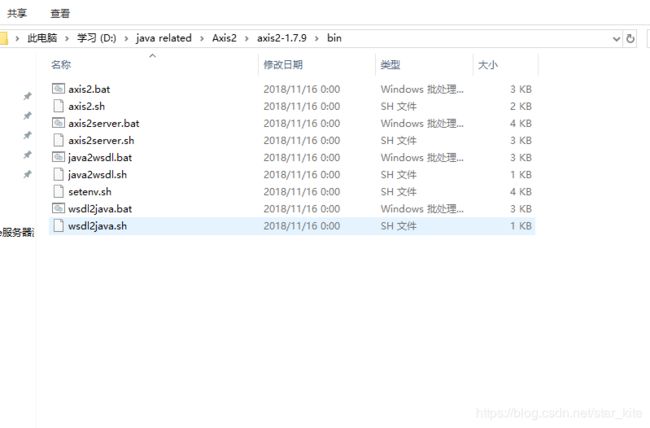WebService学习之路
最近工作中用到了webService,之前也稍微学习了一点,不过从来没用过所以忘的差不多了,这一次主要是以应用为主。
主要用的是Axis2的方式进行webservice应用的,主要有三种方式
第一RPC方式,不生成客户端代码
第二,document方式,不生成客户端代码
第三,用wsdl2java工具,生成客户端方式调用
我个人调用webService的方式主要是第三种,生成两个java文件后,在项目中引入依赖便可直接当作java使用。
主要步骤为下载axis2-1.7.9-bin.zip客户端
解压缩后,切换到bin目录下
然后打开cmd,输入命令
wsdl2java -uri C:\Users\13920\Desktop\WebService\webservice服务器测试程序\PatrolSystem.wsdl -p com.patrol.test -o e:\test
-uri代表wsdl文件的路径,或者一个链接
-p代表生成的java文件所在包路径,可自己定义
-0代表生成的文件的存储路径
成功后会生成build.xml和src两个文件,src内含有包和生成的java类
调用java的方式
try {
PatrolSystemStub patrolSystemStub = new PatrolSystemStub();
PatrolSystemStub.GetRecentPatrolEvent ad= new PatrolSystemStub.GetRecentPatrolEvent();
PatrolSystemStub.GetPatrolBayInfo bayInfo= new PatrolSystemStub.GetPatrolBayInfo();
System.out.println(patrolSystemStub.getPatrolBayInfo(bayInfo).getBayInfos());
} catch (AxisFault e) {
// TODO Auto-generated catch block
e.printStackTrace();
} catch (RemoteException e) {
// TODO Auto-generated catch block
e.printStackTrace();
}下面的demo主要来自于https://blog.csdn.net/zhangmeng_07/article/details/54694277
package samples.quickstart.client;
import javax.xml.namespace.QName;
import org.apache.axiom.om.OMAbstractFactory;
import org.apache.axiom.om.OMElement;
import org.apache.axiom.om.OMFactory;
import org.apache.axiom.om.OMNamespace;
import org.apache.axis2.AxisFault;
import org.apache.axis2.addressing.EndpointReference;
import org.apache.axis2.client.Options;
import org.apache.axis2.client.ServiceClient;
import org.apache.axis2.rpc.client.RPCServiceClient;
import samples.quickstart.StockQuoteServiceStub;
import samples.quickstart.xsd.GetPrice;
import samples.quickstart.xsd.GetPriceResponse;
public class StockQuoteClient {
/**
* 方法一:
* 应用rpc的方式调用 这种方式就等于远程调用,
* 即通过url定位告诉远程服务器,告知方法名称,参数等, 调用远程服务,得到结果。
* 使用 org.apache.axis2.rpc.client.RPCServiceClient类调用WebService
*
【注】:
如果被调用的WebService方法有返回值 应使用 invokeBlocking 方法 该方法有三个参数
第一个参数的类型是QName对象,表示要调用的方法名;
第二个参数表示要调用的WebService方法的参数值,参数类型为Object[];
当方法没有参数时,invokeBlocking方法的第二个参数值不能是null,而要使用new Object[]{}。
第三个参数表示WebService方法的 返回值类型的Class对象,参数类型为Class[]。
如果被调用的WebService方法没有返回值 应使用 invokeRobust 方法
该方法只有两个参数,它们的含义与invokeBlocking方法的前两个参数的含义相同。
在创建QName对象时,QName类的构造方法的第一个参数表示WSDL文件的命名空间名,
也就是 元素的targetNamespace属性值。
*
*/
public static void testRPCClient() {
try {
// axis1 服务端
// String url = "http://localhost:8080/StockQuote/services/StockQuoteServiceSOAP11port?wsdl";
// axis2 服务端
String url = "http://localhost:8080/axis2ServerDemo/services/StockQuoteService?wsdl";
// 使用RPC方式调用WebService
RPCServiceClient serviceClient = new RPCServiceClient();
// 指定调用WebService的URL
EndpointReference targetEPR = new EndpointReference(url);
Options options = serviceClient.getOptions();
//确定目标服务地址
options.setTo(targetEPR);
//确定调用方法
options.setAction("urn:getPrice");
/**
* 指定要调用的getPrice方法及WSDL文件的命名空间
* 如果 webservice 服务端由axis2编写
* 命名空间 不一致导致的问题
* org.apache.axis2.AxisFault: java.lang.RuntimeException: Unexpected subelement arg0
*/
QName qname = new QName("http://quickstart.samples/xsd", "getPrice");
// 指定getPrice方法的参数值
Object[] parameters = new Object[] { "13" };
// 指定getPrice方法返回值的数据类型的Class对象
Class[] returnTypes = new Class[] { double.class };
// 调用方法一 传递参数,调用服务,获取服务返回结果集
OMElement element = serviceClient.invokeBlocking(qname, parameters);
//值得注意的是,返回结果就是一段由OMElement对象封装的xml字符串。
//我们可以对之灵活应用,下面我取第一个元素值,并打印之。因为调用的方法返回一个结果
String result = element.getFirstElement().getText();
System.out.println(result);
// 调用方法二 getPrice方法并输出该方法的返回值
Object[] response = serviceClient.invokeBlocking(qname, parameters, returnTypes);
// String r = (String) response[0];
Double r = (Double) response[0];
System.out.println(r);
} catch (AxisFault e) {
e.printStackTrace();
}
}
/**
* 方法二: 应用document方式调用(构建请求报文)
* 用ducument方式应用现对繁琐而灵活。现在用的比较多。因为真正摆脱了我们不想要的耦合
*/
public static void testDocument() {
try {
// String url = "http://localhost:8080/axis2ServerDemo/services/StockQuoteService";
String url = "http://localhost:8080/StockQuote/services/StockQuoteServiceSOAP11port?wsdl";
Options options = new Options();
// 指定调用WebService的URL
EndpointReference targetEPR = new EndpointReference(url);
options.setTo(targetEPR);
// options.setAction("urn:getPrice");
ServiceClient sender = new ServiceClient();
sender.setOptions(options);
OMFactory fac = OMAbstractFactory.getOMFactory();
String tns = "http://quickstart.samples/";
// 命名空间,有时命名空间不增加没事,不过最好加上,因为有时有事,你懂的
// 第一个参数命名空间地址,第二个参数是命名空间前缀
OMNamespace omNs = fac.createOMNamespace(tns, "");
// 第一个参数是构建标签名称,第二个参数是命名空间
OMElement method = fac.createOMElement("getPrice", omNs);
OMElement symbol = fac.createOMElement("symbol", omNs);
// 标签设值
symbol.setText("13");
//symbol.addChild(fac.createOMText(symbol, "Axis2 Echo String "));
// 添加子标签
method.addChild(symbol);
// 构建报文
method.build();
// 发送请求返回报文
OMElement result = sender.sendReceive(method);
System.out.println(result);
} catch (AxisFault axisFault) {
axisFault.printStackTrace();
}
}
/**
* 为SOAP Header构造验证信息,
* 如果你的服务端是没有验证的,那么你不用在Header中增加验证信息
*
* @param serviceClient
* @param tns 命名空间
* @param user
* @param passwrod
*/
public void addValidation(ServiceClient serviceClient, String tns , String user, String passwrod) {
OMFactory fac = OMAbstractFactory.getOMFactory();
OMNamespace omNs = fac.createOMNamespace(tns, "nsl");
OMElement header = fac.createOMElement("AuthenticationToken", omNs);
OMElement ome_user = fac.createOMElement("Username", omNs);
OMElement ome_pass = fac.createOMElement("Password", omNs);
ome_user.setText(user);
ome_pass.setText(passwrod);
header.addChild(ome_user);
header.addChild(ome_pass);
serviceClient.addHeader(header);
}
/**
* 方法三:利用axis2插件生成客户端方式调用
*
*/
public static void testCodeClient() {
try {
String url = "http://localhost:8080/axis2ServerDemo/services/StockQuoteService";
StockQuoteServiceStub stub = new StockQuoteServiceStub(url);
GetPrice request = new GetPrice();
request.setSymbol("ABCD");
GetPriceResponse response = stub.getPrice(request);
System.out.println(response.get_return());
} catch (org.apache.axis2.AxisFault e) {
e.printStackTrace();
} catch (java.rmi.RemoteException e) {
e.printStackTrace();
}
}
public static void main(String[] args) {
StockQuoteClient.testRPCClient();
// StockQuoteClient.testDocument();
// StockQuoteClient.testCodeClient();
}
}

